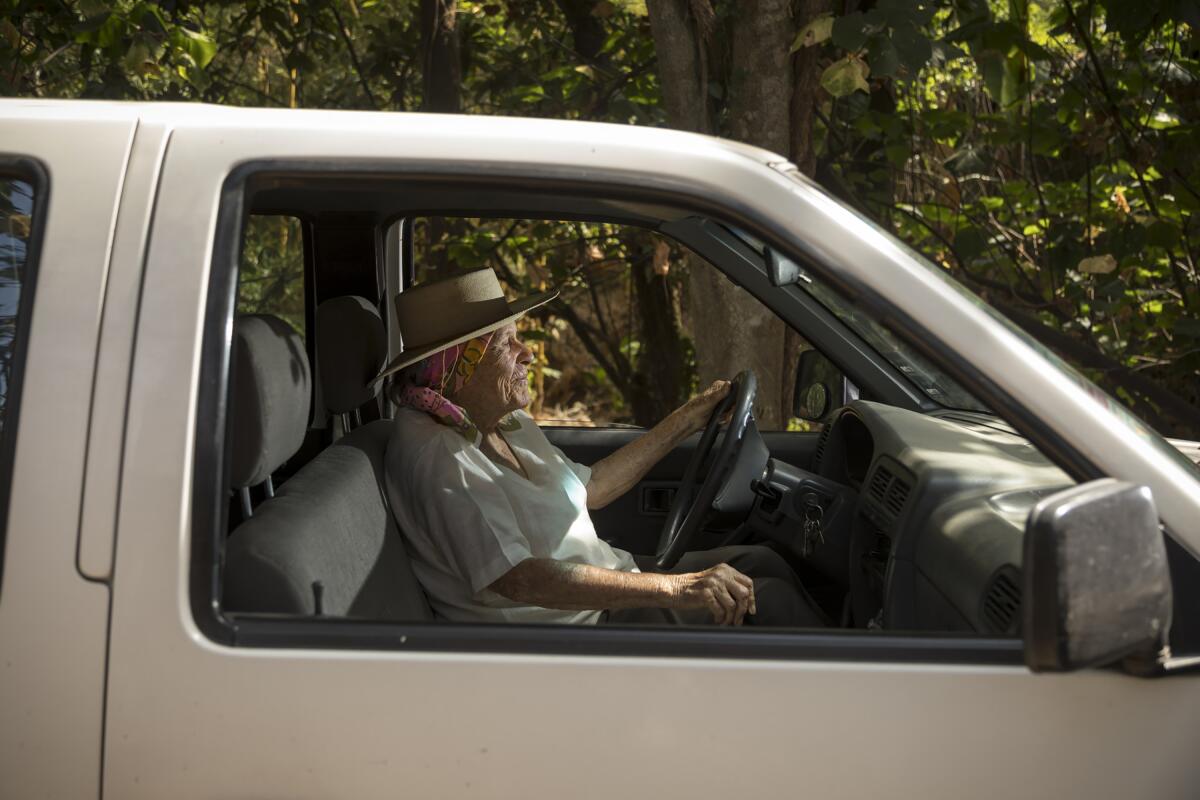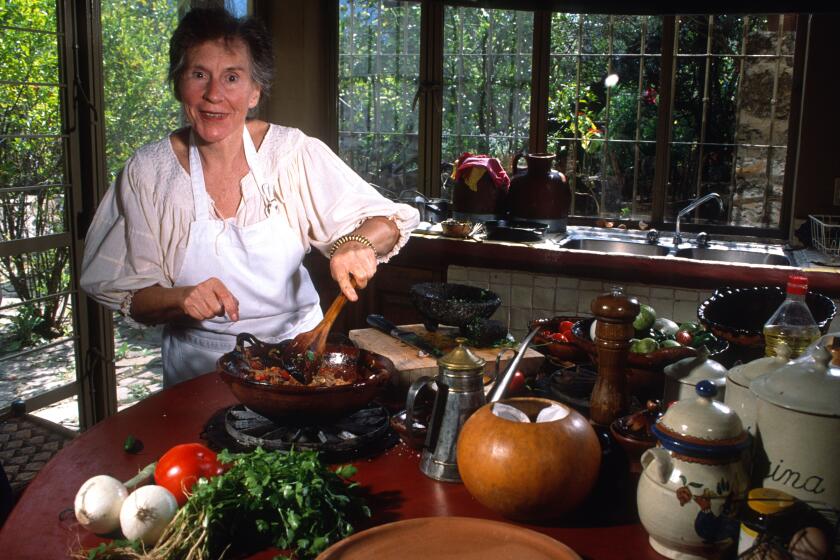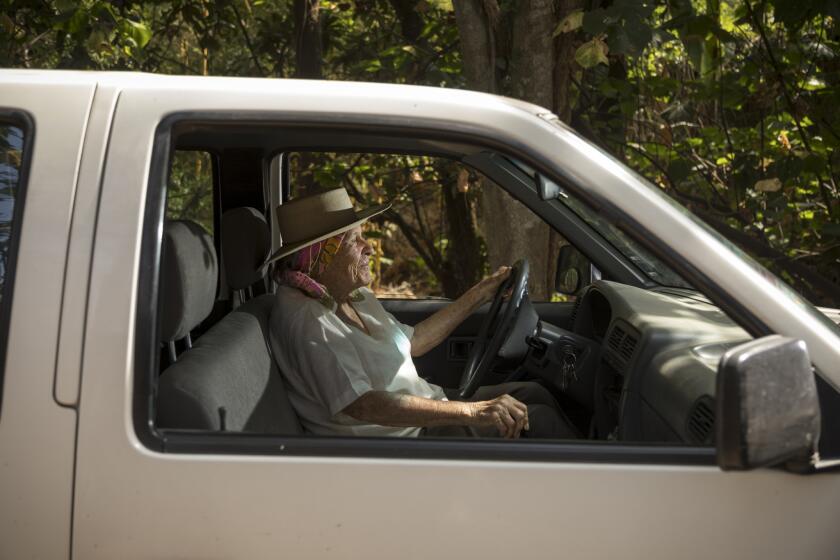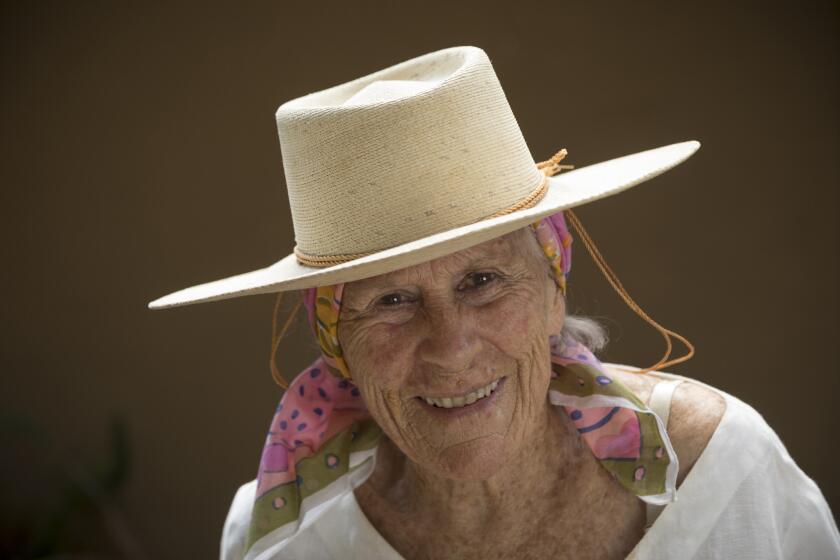Diana Kennedy, who spent decades documenting Mexican regional cuisines, dies at 99
- Share via
Diana Kennedy, the British-born author who translated her love of Mexican cuisine into cookbooks that made hundreds of regional recipes accessible to home cooks in the U.S. at a time when many still thought of the cuisine as little more than combo plates and tacos, has died at her home in the Mexican state of Michoacán. She was 99.
Her death was confirmed by the Mexican government via Twitter and by longtime friend and collaborator, chef Gabriela Cámara. She died Sunday morning at 5 a.m. of respiratory failure, Cámara said.
“Everybody in Mexico or anybody who was halfway cultured in Mexico always knew that the biodiversity and cultural diversity of Mexico was out of this world, but for Americans it was certainly a surprise,” Cámara told The Times on Sunday. “She was the first person to write in English about the diversity of Mexican food, so she deserves that honor.”
Starting with her first book, “The Cuisines of Mexico,” published in 1972, Kennedy did for Mexican cooking what Julia Child had done for French cuisine. She provided regional versions of such familiar fare as enchiladas and tamales and also introduced her readers to such subtle and complex dishes as duck in pumpkin seed mole and cream of squash flower soup. She also tucked recipes into her books for tarts filled with a mash of aquatic flies’ eggs and stews of black iguana.
Throughout her career she held to her view that fine Mexican dining was the equal of any in the world. “This, with its strong peasant roots, is the haute cuisine of Mexico,” she said of the more complex recipes in her books, in a 1992 interview with The Times. “As much time and trouble should go into the preparation as into that of any intricate French dish.”
“Diana went to Mexico and got it, right away, that she was in the presence of something extraordinary, something that wasn’t particularly valued even by the Mexican people,” Fran McCullough, Kennedy’s editor for more than 20 years, told The Times.
She was an amateur food anthropologist as well as a cook who traveled the country to learn more about her subject. Her writing exudes a “ferocious desire to explore, reveal and preserve” traditional Mexican dishes, noted a 1999 review in The Times.
At times Kennedy added a taste of the cultural life that flavored a recipe. “Open the steamer and bless it with a double sign of the cross” she wrote in the instructions for “tamales de espiga,” a type of corn tamale that threatened to be bland. She was taught to make the dish with the devotion included, she wrote in 1998’s “My Mexico,” and she did so even though she was a pantheist.
In the kitchen with a feisty Diana Kennedy as she argues with Mexican cooks over tamale prep and teaches health-obsessed white cooks to relax about chiles.
Kennedy’s books include “The Tortilla Book” (1975), “Mexican Regional Cooking” (1990) and “From My Mexican Kitchen” (2003), with her final release being a 2016 reissue of her semi-memoir “Nothing Fancy: Recipes and Recollections of Soul-Satisfying Food.”
Although Kennedy wrote for home cooks, she inspired restaurant chefs and owners as well, who wanted to offer something new to generations of eaters who loved Mexican food but were eager to try new-to-them styles.
“Diana wants things done right. Her integrity stands out,” said Tom Gilliland, a friend of Kennedy and owner of Fonda San Miguel restaurant in Austin, Texas. She helped him plan the restaurant’s first menu after she visited it in the early 1970s. Gilliland and the restaurant’s late chef and part owner, Miguel Ravago, had both read her book “The Cuisines of Mexico” before they met her. The array of regional dishes impressed them.
“We knew the kind of food in that book was exactly what we wanted to serve in the restaurant,” Gilliland said. At first he couldn’t find the fresh ingredients he needed, even in Texas, so he imported chipotle and a wide variety of chiles.
At home in her Mexican kitchen, Kennedy made everything from scratch, grinding corn kernels into meal for tamale dough and gutting a chicken to prepare it for roasting. She gave instructions for these techniques in several of her books, but said she didn’t expect that most of her readers would follow them. “My books are for learning, and for cooking,” she said.
“Kennedy’s labor of love and scholarship belongs in the home library as a chronicle of culinary culture, regardless of whether or not cooks decide to turn their kitchen into cantinas,” declared a 1989 review in Publishers Weekly of her book “The Art of Mexican Cooking.”
Since the late 1970s she resided in an ecological house with solar and wind power, surrounded by four acres of organic vegetable gardens in Coatepec de Morelos, a village near the city of Zitácuaro, about 100 miles west of Mexico City.
In “Nothing Fancy,” which premieres virtually Friday, the queen of Mexican regional cooking confronts mortality and the director of her documentary.
She was fluent in Spanish and seemingly fearless, even in her 80s, when she still traveled the back roads of her adopted country in her camper truck with a CB radio and a stack of opera tapes at her side.
When she liked a new dish she tasted at a food stand, or heard about from a bus driver, farmer, fisherman or housekeeper she met in her travels, Kennedy talked her way into the kitchen of the one who made the dish and followed them around taking notes while they prepared it for her. Many of these recipes had been passed along only orally through family generations. She regularly credited by name the men and women who taught her how to prepare a family recipe.
“There has never been a moment that I can remember in which I didn’t have plans for yet another search for some unrecorded recipe, fabled regional cook, or elusive herb or chile,” Kennedy wrote in “My Mexico.”
If anyone asked her how a native of England could master the foods of Yucatan, Mexico City, Dolores Hidalgo, Veracruz and environs, she was ready for them.
“I have literally spent 20 years … eating, dining in cheap hotels and getting flea-bitten,” she said during a food editors conference in 1977. “I went to the markets with maids. I badgered grandmothers.”
As her reputation grew she became known as a purist with a generous side and a prickly side. She might thank the owners of a Mexican American restaurant where she had dined, then critique each dish, usually with a mixed review. “But I’ve had much, much worse,” she once consoled members of a family-owned restaurant in Utah.
Admirers saw her testiness as proof of her uncompromising nature. “While most cookbook authors go from book to book looking for more recipes in a vein that their readers feel comfortable with, Kennedy keeps imperiously making people stretch their limits,” a reviewer for The Times wrote in 1999.

Born Diana Southwood outside London on March 3, 1923, she was the daughter of parents who were choosy about food even if they were preparing a meal of soup and bread. “Nothing Fancy” includes some of her favorite family recipes.
During World War II she served in the Women’s Timber Corps, a group that maintained Britain’s farming industry. After the war she moved to Canada and worked at the Wedgwood china company, creating table settings.
On a trip to Haiti in 1957 she met Paul Kennedy, a correspondent for the New York Times covering Mexico, Central America and the Caribbean. Soon afterward she moved to Mexico where she and Kennedy married. “I was always an adventurer,” she said.
As a newcomer to the country she was inspired by “the marvelous markets, wonderful colors, the exotic surroundings,” she said in a 1998 interview with The Times. After several years of practice she made a traditional Mexican dinner for then New York Times food critic Craig Claiborne who came to visit the Kennedys in the mid-1960s. Claiborne encouraged her to write a cookbook.
Soon afterward she and her husband moved to New York City because Paul Kennedy was ill with cancer. He died in 1967.
Back in New York, she taught and wrote in New York for more than 10 years, mostly from her home. Mexican cooking ingredients were hard to find there at the time. On one trip to California in 1976, she filled a suitcase with fresh poblano chili peppers, semi-soft cheeses and the spices commonly found in a Mexican kitchen. She also dug up an epazote, an herb that grows wild in California and Mexico, and brought it east.
She often visited Mexico during those years and began building her own house there in the late 1970s. Despite setbacks, including a fight to get water rights for her land, she persisted. The townspeople called her the “gringa loca (crazy white lady).”
Her vision of the life she wanted to lead kept her going. “I wanted a center for my studies of Mexican foods,” she said about her decision. That and to live like a local and “plant trees and help the earth come alive after so many years of neglect.”
At times she taught cooking classes for small groups in her home, with the kitchen shelves lined by earthenware pots and a beehive oven outside the door.
She filled her hillside property with vegetable gardens and fruit trees, kept beehives that produced about 20 gallons of organic honey each year and had a barnyard of pigs, goats, chickens and ducks.
She continued to travel and collect recipes as she had for more than 50 years.
“I am always realizing how very little I know,” she said. “Never call yourself an expert and never claim to write the complete book of anything.”
In 1981 the Mexican government presented Kennedy with the Order of the Aztec Eagle, the highest honor given to a foreigner, for teaching the world about Mexico’s food traditions.
Kennedy last appeared in Los Angeles in public in 2019, as she promoted a documentary about her life and work, “Nothing Fancy,” in which she extolled her mantras of preserving original ingredients and culinary knowledge that she argued was dying away and close to becoming forgotten.
True to her often prickly nature, she predicted in the film she had about five more years to live, and characterized her death as a choice.
“I have planned only five [more] years, and nobody can say no,” Kennedy says in the film. “There’s a time, it’s like the caducidad, the date on your ingredients you buy, OK? They last so long.”
Rourke is a former Times staff writer. Food editor Daniel Hernandez contributed to this report.
More to Read
Start your day right
Sign up for Essential California for the L.A. Times biggest news, features and recommendations in your inbox six days a week.
You may occasionally receive promotional content from the Los Angeles Times.










